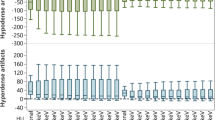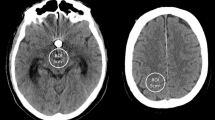Abstract
Purpose
To compare and to combine iterative metal artifact reduction (MAR) and virtual monoenergetic extrapolations (VMEs) from dual-energy computed tomography (DECT) for reducing metal artifacts from intracranial clips and coils.
Methods
Fourteen clips and six coils were scanned in a phantom model with DECT at 100 and 150SnkVp. Four datasets were reconstructed: non-corrected images (filtered-back projection), iterative MAR, VME from DECT at 120 keV, and combined iterative MAR + VME images. Artifact severity scores and visibility of simulated, contrast-filled, adjacent vessels were assessed qualitatively and quantitatively by two independent, blinded readers.
Results
Iterative MAR, VME, and combined iterative MAR + VME resulted in a significant reduction of qualitative (p < 0.001) and quantitative clip artifacts (p < 0.005) and improved the visibility of adjacent vessels (p < 0.05) compared to non-corrected images, with lowest artifact scores found in combined iterative MAR + VME images. Titanium clips demonstrated less artifacts than Phynox clips (p < 0.05), and artifact scores increased with clip size. Coil artifacts increased with coil size but were reducible when applying iterative MAR + VME compared to non-corrected images. However, no technique improved the severe artifacts from large, densely packed coils.
Conclusions
Combining iterative MAR with VME allows for an improved metal artifact reduction from clips and smaller, loosely packed coils. Limited value was found for large and densely packed coils.








Similar content being viewed by others
References
van Rooij WJ, Sluzewski M (2009) Opinion: imaging follow-up after coiling of intracranial aneurysms. AJNR Am J Neuroradiol 30(9):1646–1648. https://doi.org/10.3174/ajnr.A1673
Li H, Pan R, Wang H, Rong X, Yin Z, Milgrom DP, Shi X, Tang Y, Peng Y (2013) Clipping versus coiling for ruptured intracranial aneurysms: a systematic review and meta-analysis. Stroke 44(1):29–37. https://doi.org/10.1161/STROKEAHA.112.663559
Psychogios MN, Scholz B, Rohkohl C, Kyriakou Y, Mohr A, Schramm P, Wachter D, Wasser K, Knauth M (2013) Impact of a new metal artefact reduction algorithm in the noninvasive follow-up of intracranial clips, coils, and stents with flat-panel angiographic CTA: initial results. Neuroradiology 55(7):813–818. https://doi.org/10.1007/s00234-013-1165-6
Wallace RC, Karis JP, Partovi S, Fiorella D (2007) Noninvasive imaging of treated cerebral aneurysms, part II: CT angiographic follow-up of surgically clipped aneurysms. AJNR Am J Neuroradiol 28(7):1207–1212. https://doi.org/10.3174/ajnr.A0664
Kaufmann TJ, Huston J 3rd, Mandrekar JN, Schleck CD, Thielen KR, Kallmes DF (2007) Complications of diagnostic cerebral angiography: evaluation of 19,826 consecutive patients. Radiology 243(3):812–819. https://doi.org/10.1148/radiol.2433060536
Jiang L, He ZH, Zhang XD, Lin B, Yin XH, Sun XC (2011) Value of noninvasive imaging in follow-up of intracranial aneurysm. Acta Neurochir Suppl 110(Pt 2):227–232. https://doi.org/10.1007/978-3-7091-0356-2_41
Sagara Y, Kiyosue H, Hori Y, Sainoo M, Nagatomi H, Mori H (2005) Limitations of three-dimensional reconstructed computerized tomography angiography after clip placement for intracranial aneurysms. J Neurosurg 103(4):656–661. https://doi.org/10.3171/jns.2005.103.4.0656
Buhk JH, Kallenberg K, Mohr A, Dechent P, Knauth M (2009) Evaluation of angiographic computed tomography in the follow-up after endovascular treatment of cerebral aneurysms—a comparative study with DSA and TOF-MRA. Eur Radiol 19(2):430–436. https://doi.org/10.1007/s00330-008-1171-y
Kovacs A, Flacke S, Tschampa H, Hadizadeh D, Greschus S, Clusmann H, Kristof R, Urbach H (2010) Gated multidetector computed tomography. A technique to reduce intracranial aneurysm clip and coil artifacts. Clin Neuroradiol 20(2):99–107. https://doi.org/10.1007/s00062-010-0001-1
van der Schaaf I, van Leeuwen M, Vlassenbroek A, Velthuis B (2006) Minimizing clip artifacts in multi CT angiography of clipped patients. AJNR Am J Neuroradiol 27(1):60–66
De Crop A, Casselman J, Van Hoof T, Dierens M, Vereecke E, Bossu N, Pamplona J, D'Herde K, Thierens H, Bacher K (2015) Analysis of metal artifact reduction tools for dental hardware in CT scans of the oral cavity: kVp, iterative reconstruction, dual-energy CT, metal artifact reduction software: does it make a difference? Neuroradiology 57(8):841–849. https://doi.org/10.1007/s00234-015-1537-1
Meyer E, Raupach R, Lell M, Schmidt B, Kachelriess M (2010) Normalized metal artifact reduction (NMAR) in computed tomography. Med Phys 37(10):5482–5493. https://doi.org/10.1118/1.3484090
Meyer E, Raupach R, Lell M, Schmidt B, Kachelriess M (2012) Frequency split metal artifact reduction (FSMAR) in computed tomography. Med Phys 39(4):1904–1916. https://doi.org/10.1118/1.3691902
Morsbach F, Wurnig M, Kunz DM, Krauss A, Schmidt B, Kollias SS, Alkadhi H (2013) Metal artefact reduction from dental hardware in carotid CT angiography using iterative reconstructions. Eur Radiol 23(10):2687–2694. https://doi.org/10.1007/s00330-013-2885-z
Bamberg F, Dierks A, Nikolaou K, Reiser MF, Becker CR, Johnson TR (2011) Metal artifact reduction by dual energy computed tomography using monoenergetic extrapolation. Eur Radiol 21(7):1424–1429. https://doi.org/10.1007/s00330-011-2062-1
Winklhofer S, Benninger E, Spross C, Morsbach F, Rahm S, Ross S, Jost B, Thali MJ, Stolzmann P, Alkadhi H, Guggenberger R (2014) CT metal artefact reduction for internal fixation of the proximal humerus: value of mono-energetic extrapolation from dual-energy and iterative reconstructions. Clin Radiol 69(5):e199–e206. https://doi.org/10.1016/j.crad.2013.12.011
Bier G, Bongers MN, Hempel JM, Orgel A, Hauser TK, Ernemann U, Hennersdorf F (2017) Follow-up CT and CT angiography after intracranial aneurysm clipping and coiling-improved image quality by iterative metal artifact reduction. Neuroradiology 59(7):649–654. https://doi.org/10.1007/s00234-017-1855-6
Dunet V, Bernasconi M, Hajdu SD, Meuli RA, Daniel RT, Zerlauth JB (2017) Impact of metal artifact reduction software on image quality of gemstone spectral imaging dual-energy cerebral CT angiography after intracranial aneurysm clipping. Neuroradiology 59(9):845–852. https://doi.org/10.1007/s00234-017-1871-6
Dolati P, Eichberg D, Wong JH, Goyal M (2015) The utility of dual-energy computed tomographic angiography for the evaluation of brain aneurysms after surgical clipping: a prospective study. World Neurosurg 84(5):1362–1371. https://doi.org/10.1016/j.wneu.2015.06.027
Jia Y, Zhang J, Fan J, Li C, Sun Y, Li D, Xiao X (2015) Gemstone spectral imaging reduced artefacts from metal coils or clips after treatment of cerebral aneurysms: a retrospective study of 35 patients. Br J Radiol 88(1055):20150222. https://doi.org/10.1259/bjr.20150222
Higashigaito K, Angst F, Runge VM, Alkadhi H, Donati OF (2015) Metal artifact reduction in pelvic computed tomography with hip prostheses: comparison of virtual monoenergetic extrapolations from dual-energy computed tomography and an iterative metal artifact reduction algorithm in a phantom study. Investig Radiol 50(12):828–834. https://doi.org/10.1097/RLI.0000000000000191
Morsbach F, Bickelhaupt S, Wanner GA, Krauss A, Schmidt B, Alkadhi H (2013) Reduction of metal artifacts from hip prostheses on CT images of the pelvis: value of iterative reconstructions. Radiology 268(1):237–244. https://doi.org/10.1148/radiol.13122089
Guggenberger R, Winklhofer S, Osterhoff G, Wanner GA, Fortunati M, Andreisek G, Alkadhi H, Stolzmann P (2012) Metallic artefact reduction with monoenergetic dual-energy CT: systematic ex vivo evaluation of posterior spinal fusion implants from various vendors and different spine levels. Eur Radiol 22(11):2357–2364. https://doi.org/10.1007/s00330-012-2501-7
Meinel FG, Bischoff B, Zhang Q, Bamberg F, Reiser MF, Johnson TR (2012) Metal artifact reduction by dual-energy computed tomography using energetic extrapolation: a systematically optimized protocol. Investig Radiol 47(7):406–414. https://doi.org/10.1097/RLI.0b013e31824c86a3
Lane BF, Vandermeer FQ, Oz RC, Irwin EW, McMillan AB, Wong-You-Cheong JJ (2011) Comparison of sagittal T2-weighted BLADE and fast spin-echo MRI of the female pelvis for motion artifact and lesion detection. AJR Am J Roentgenol 197(2):W307–W313. https://doi.org/10.2214/AJR.10.5918
Landis JR, Koch GG (1977) The measurement of observer agreement for categorical data. Biometrics 33(1):159–174. https://doi.org/10.2307/2529310
Kirkwood BR, Sterne JAC, Kirkwood BR (2003) Essential medical statistics, 2nd edn. Blackwell Science, Malden
van Loon JJ, Yousry TA, Fink U, Seelos KC, Reulen HJ, Steiger HJ (1997) Postoperative spiral computed tomography and magnetic resonance angiography after aneurysm clipping with titanium clips. Neurosurgery 41(4):851–856; discussion 856-857. https://doi.org/10.1097/00006123-199710000-00016
Wang F, Zhang Y, Xue H, Han W, Yang X, Jin Z, Zwar R (2017) Combined use of iterative reconstruction and monochromatic imaging in spinal fusion CT images. Acta Radiol 58(1):62–69. https://doi.org/10.1177/0284185116631182
Bongers MN, Schabel C, Thomas C, Raupach R, Notohamiprodjo M, Nikolaou K, Bamberg F (2015) Comparison and combination of dual-energy- and iterative-based metal artefact reduction on hip prosthesis and dental implants. PLoS One 10(11):e0143584. https://doi.org/10.1371/journal.pone.0143584
Hegde A, Chan LL, Tan L, Illyyas M, Lim WE (2009) Dual energy CT and its use in neuroangiography. Ann Acad Med Singap 38(9):817–820
Bakker NA, Westerlaan HE, Metzemaekers JD, van Dijk JM, Eshghi OS, Mooij JJ, Groen RJ (2010) Feasibility of magnetic resonance angiography (MRA) follow-up as the primary imaging modality after coiling of intracranial aneurysms. Acta Radiol 51(2):226–232. https://doi.org/10.3109/02841850903436642
Abdulazim A, Rubbert C, Reichelt D, Mathys C, Turowski B, Steiger HJ, Hanggi D, Etminan N (2017) Dual- versus single-energy CT-angiography imaging for patients undergoing intracranial aneurysm repair. Cerebrovasc Dis 43(5–6):272–282. https://doi.org/10.1159/000464356
Steiner T, Juvela S, Unterberg A, Jung C, Forsting M, Rinkel G, European Stroke O (2013) European stroke organization guidelines for the management of intracranial aneurysms and subarachnoid haemorrhage. Cerebrovasc Dis 35(2):93–112. https://doi.org/10.1159/000346087
Pechlivanis I, Harders A, Tuttenberg J, Barth M, Schulte-Altedorneburg G, Schmieder K (2009) Computed tomographic angiography: diagnostic procedure of choice in the management of subarachnoid hemorrhage in the elderly patient? Cerebrovasc Dis 28(5):481–489. https://doi.org/10.1159/000236526
van der Jagt M, Flach HZ, Tanghe HL, Bakker SL, Hunink MG, Koudstaal PJ, van der Lugt A (2008) Assessment of feasibility of endovascular treatment of ruptured intracranial aneurysms with 16-detector row CT angiography. Cerebrovasc Dis 26(5):482–488. https://doi.org/10.1159/000155985
Author information
Authors and Affiliations
Corresponding author
Ethics declarations
Funding
No funding was received for this study.
Conflicts of interest
The authors declare that they have no conflict of interest.
Ethical approval
This article does not contain any studies with human participants or animals performed by any of the authors.
Informed consent
Not applicable.
Rights and permissions
About this article
Cite this article
Winklhofer, S., Hinzpeter, R., Stocker, D. et al. Combining monoenergetic extrapolations from dual-energy CT with iterative reconstructions: reduction of coil and clip artifacts from intracranial aneurysm therapy. Neuroradiology 60, 281–291 (2018). https://doi.org/10.1007/s00234-018-1981-9
Received:
Accepted:
Published:
Issue Date:
DOI: https://doi.org/10.1007/s00234-018-1981-9




